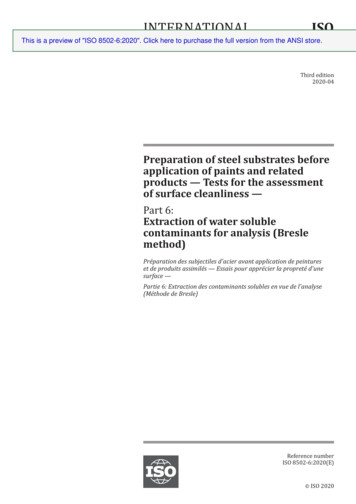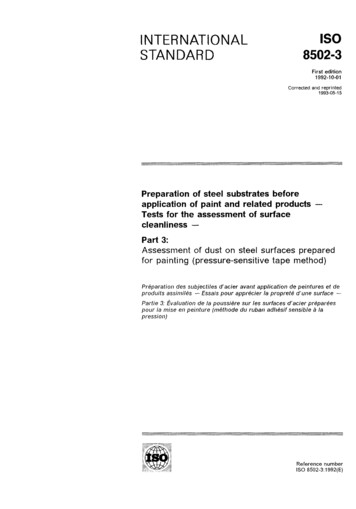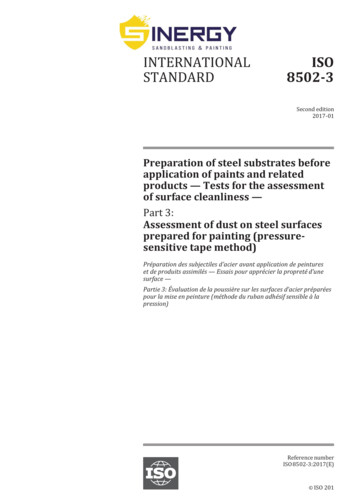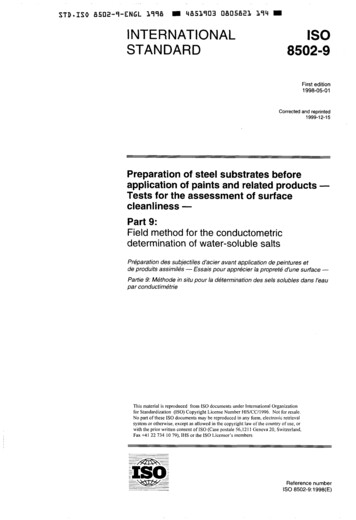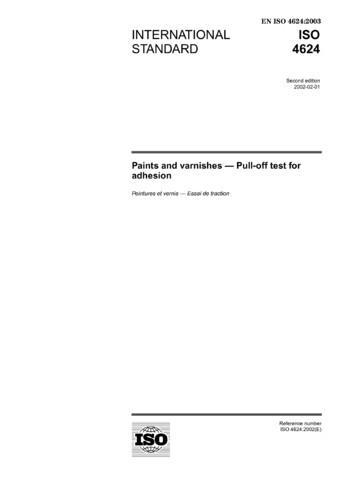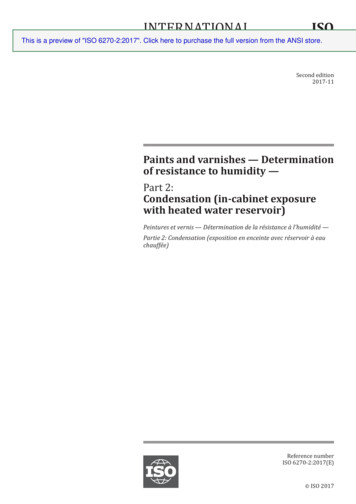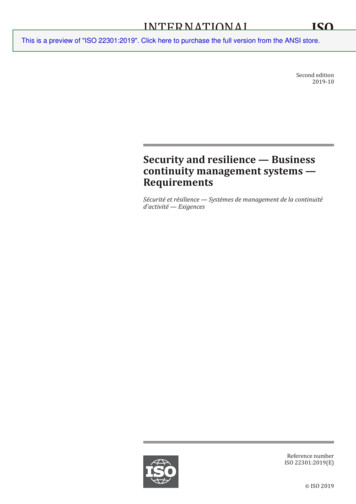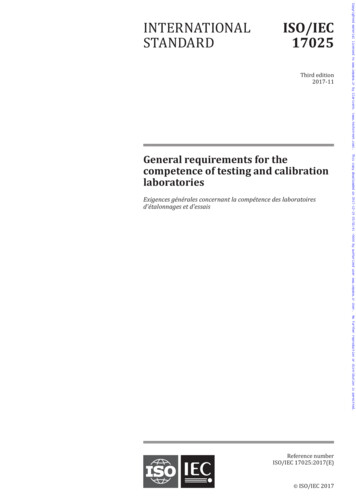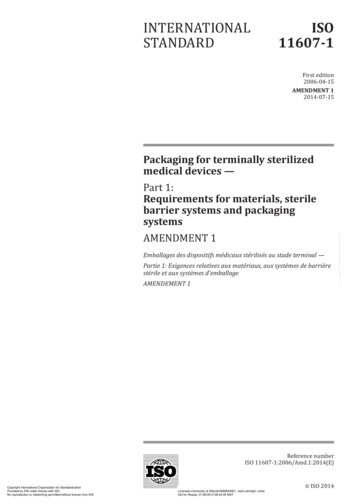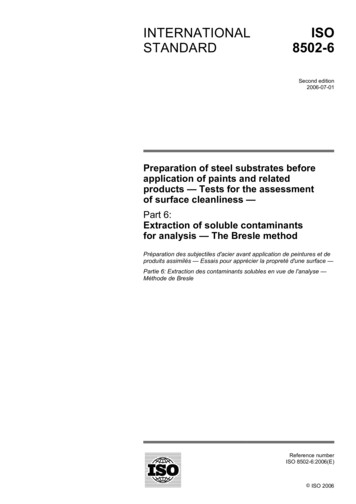
Transcription
INTERNATIONALSTANDARDISO8502-6Second edition2006-07-01Preparation of steel substrates beforeapplication of paints and relatedproducts — Tests for the assessmentof surface cleanliness —Part 6:Extraction of soluble contaminantsfor analysis — The Bresle methodPréparation des subjectiles d'acier avant application de peintures et deproduits assimilés — Essais pour apprécier la propreté d'une surface —Partie 6: Extraction des contaminants solubles en vue de l'analyse —Méthode de BresleReference numberISO 8502-6:2006(E) ISO 2006
ISO 8502-6:2006(E)PDF disclaimerThis PDF file may contain embedded typefaces. In accordance with Adobe's licensing policy, this file may be printed or viewed butshall not be edited unless the typefaces which are embedded are licensed to and installed on the computer performing the editing. Indownloading this file, parties accept therein the responsibility of not infringing Adobe's licensing policy. The ISO Central Secretariataccepts no liability in this area.Adobe is a trademark of Adobe Systems Incorporated.Details of the software products used to create this PDF file can be found in the General Info relative to the file; the PDF-creationparameters were optimized for printing. Every care has been taken to ensure that the file is suitable for use by ISO member bodies. Inthe unlikely event that a problem relating to it is found, please inform the Central Secretariat at the address given below. ISO 2006All rights reserved. Unless otherwise specified, no part of this publication may be reproduced or utilized in any form or by any means,electronic or mechanical, including photocopying and microfilm, without permission in writing from either ISO at the address below orISO's member body in the country of the requester.ISO copyright officeCase postale 56 CH-1211 Geneva 20Tel. 41 22 749 01 11Fax 41 22 749 09 47E-mail copyright@iso.orgWeb www.iso.orgPublished in Switzerlandii ISO 2006 – All rights reserved
ISO 8502-6:2006(E)ContentsPageForeword. ivIntroduction . v1Scope . 12Normative references . 13Principle . 14Apparatus and materials . 25Procedure . 26Test report . 3Annex A (normative) Leak test for type testing of patches . 6 ISO 2006 – All rights reservediii
ISO 8502-6:2006(E)ForewordISO (the International Organization for Standardization) is a worldwide federation of national standards bodies(ISO member bodies). The work of preparing International Standards is normally carried out through ISOtechnical committees. Each member body interested in a subject for which a technical committee has beenestablished has the right to be represented on that committee. International organizations, governmental andnon-governmental, in liaison with ISO, also take part in the work. ISO collaborates closely with theInternational Electrotechnical Commission (IEC) on all matters of electrotechnical standardization.International Standards are drafted in accordance with the rules given in the ISO/IEC Directives, Part 2.The main task of technical committees is to prepare International Standards. Draft International Standardsadopted by the technical committees are circulated to the member bodies for voting. Publication as anInternational Standard requires approval by at least 75 % of the member bodies casting a vote.Attention is drawn to the possibility that some of the elements of this document may be the subject of patentrights. ISO shall not be held responsible for identifying any or all such patent rights.ISO 8502-6 was prepared by Technical Committee ISO/TC 35, Paints and varnishes, Subcommittee SC 12,Preparation of steel substrates before application of paints and related products.This second edition cancels and replaces the first edition (ISO 8502-6:1995), which has been revised to clarifythe procedure (see 5.6 and 5.7).ISO 8502 consists of the following parts, under the general title Preparation of steel substrates beforeapplication of paints and related products — Tests for the assessment of surface cleanliness: Part 2: Laboratory determination of chloride on cleaned surfaces Part 3: Assessment of dust on steel surfaces prepared for painting (pressure-sensitive tape method) Part 4: Guidance on the estimation of the probability of condensation prior to paint application Part 5: Measurement of chloride on steel surfaces prepared for painting (ion detection tube method) Part 6: Extraction of soluble contaminants for analysis — The Bresle method Part 8: Field method for the refractometric determination of moisture Part 9: Field method for the conductometric determination of water-soluble salts Part 11: Field method for the turbidimetric determination of water-soluble sulfate Part 12: Field method for the titrimetric determination of water-soluble ferrous ionsParts 1 and 10 have been withdrawn. Part 7 (Field method for the determination of oil and grease) is inpreparation.iv ISO 2006 – All rights reserved
ISO 8502-6:2006(E)IntroductionThe performance of protective coatings of paint and related products applied to steel is significantly affectedby the state of the steel surface immediately prior to painting. The principal factors that are known to influencethis performance are:a)the presence of rust and mill scale;b)the presence of surface contaminants, including salts, dust, oils and greases;c)the surface profile.International Standards ISO 8501, ISO 8502 and ISO 8503 have been prepared to provide methods ofassessing these factors, while ISO 8504 provides guidance on the preparation methods that are available forcleaning steel substrates, indicating the capabilities of each in attaining specified levels of cleanliness.These International Standards do not contain recommendations for the protective coating systems to beapplied to the steel surface. Neither do they contain recommendations for the surface quality requirements forspecific situations, even though surface quality can have a direct influence on the choice of protective coatingto be applied and on its performance. Such recommendations are found in other documents such as nationalstandards and codes of practice. It will be necessary for the users of these International Standards to ensurethat the qualities specified are: compatible and appropriate both for the environmental conditions to which the steel will be exposed andfor the protective coating system to be used; within the capability of the cleaning procedure specified.The four International Standards referred to above deal with the following aspects of preparation of steelsubstrates:ISO 8501 — Visual assessment of surface cleanliness;ISO 8502 — Tests for the assessment of surface cleanliness;ISO 8503 — Surface roughness characteristics of blast-cleaned steel substrates;ISO 8504 — Surface preparation methods.Each of these International Standards is in turn divided into separate parts.This is one of a number of parts of ISO 8502 that specify tests for the assessment of surface cleanliness. Inconnection with such tests, there are several methods for the extraction, for analysis, of soluble contaminantson surfaces to be painted. Some of these methods are based on the swabbing of comparatively large testsurfaces. This technique provides average values of the contamination present, but it might conceal localizedconcentrations of contaminants. Also, swabbing might not ensure sufficient penetration to dissolve all of thedeep-seated contamination such as ferrous salts.There are other methods, however, which use small cells for the liquid used to remove and collect the surfacecontaminants. The cells (rigid or flexible) are attached to test surfaces where soluble contaminants could beexpected, e.g. where pitting has occurred. This technique usually provides more accurate, point values of thecontamination present.This part of ISO 8502 describes a simple, inexpensive field test using flexible cells in the form of adhesivepatches designed to be filled with solvent. The method was originally developed by a Swedish scientist,Dr. A. Bresle. ISO 2006 – All rights reservedv
INTERNATIONAL STANDARDISO 8502-6:2006(E)Preparation of steel substrates before application of paintsand related products — Tests for the assessment of surfacecleanliness —Part 6:Extraction of soluble contaminants for analysis — The Breslemethod1ScopeThis part of ISO 8502 describes a method of extracting, for analysis, soluble contaminants from a surface byuse of flexible cells in the form of adhesive patches which can be attached to any surface, regardless of itsshape (flat or curved) and its orientation (facing in any direction, including downwards).The method described is suitable for use in the field to determine the presence of soluble contaminants beforepainting or a similar treatment.This part of ISO 8502 does not cover the subsequent analysis of the contaminants that have been dissolvedoff. Methods of analysis suitable for field use are described in other parts of ISO 8502.2Normative referencesThe following referenced documents are indispensable for the application of this document. For datedreferences, only the edition cited applies. For undated references, the latest edition of the referenceddocument (including any amendments) applies.ISO 554, Standard atmospheres for conditioning and/or testing — SpecificationsISO 8501-1, Preparation of steel substrates before application of paints and related products — Visualassessment of surface cleanliness — Part 1: Rust grades and preparation grades of uncoated steelsubstrates and of steel substrates after removal of previous coatingsISO 8503-2, Preparation of steel substrates before application of paints and related products — Surfaceroughness characteristics of blast-cleaned steel substrates — Part 2: Method for the grading of surface profileof abrasive blast-cleaned steel — Comparator procedureISO/IEC Guide 2, Standardization and related activities — General vocabulary3PrincipleAn adhesive patch with a central compartment designed to hold a solvent is attached to the surface fromwhich soluble contaminants are to be removed. The solvent is injected into the compartment by means of asyringe, and then sucked back into the syringe. This operation is repeated a number of times. The solvent(now containing contaminants dissolved off the test surface) is then transferred to a suitable vessel foranalysis. ISO 2006 – All rights reserved1
ISO 8502-6:2006(E)4Apparatus and materials4.1 Adhesive patch, the body of which is made of ageing-resistant, flexible material with closed pores, e.g.polyethylene foam, and with a hole punched in the centre. The punched-out material is kept in the hole as areinforcement until the patch is used. One side of the patch is coated with a thin elastomer film. The other sideis coated with adhesive and covered by a removable protective sheet made of paper.NOTEThe hole and the outer edge of the patch may be any shape, e.g. circular, rectangular, elliptical, etc.The thickness of the patch shall be 1,5 mm 0,3 mm. The width of the adhesive rim between the hole and theouter edge of the patch shall be at least 5 mm. Patches with one of the standard compartment sizes specifiedin Table 1 are called standard patches.It is essential that the adhesive patch is leaktight. An easily performed leak test has therefore been developedfor type testing (see Annex A). Twelve patches of the same size shall be tested, and at least eight of themshall pass the test. The leak test shall be carried out by an accredited laboratory and the result stated in a testreport. For terms and definitions in this context, see ISO/IEC Guide 2.Table 1 — Standard patches4.2Patch sizeCompartment area (mm2)A-01551155 2A-03101310 3A-06251625 6A-12501 250 13A-25002 500 25Reusable syringe:max. cylinder volume:8 mlmax. needle diameter:1 mmmax. needle length:50 mm4.3 Solvent, chosen as a function of the surface contaminants to be determined. For the determination ofwater-soluble salts or other water-soluble contaminants, use distilled or deionized water.4.45Contact thermometer, accurate to 0,5 C and graduated at 0,5 C intervals.Procedure5.1 Take an adhesive patch (4.1) of a suitable size (see Table 1). Remove the protective paper and thepunched-out material (see Figure 1).5.2 Press the adhesive side of the patch against the test surface (see Figure 2) in such a way that theminimum amount of air is trapped in the compartment in the patch.5.3Fill the syringe (4.2) with solvent (4.3) (see Figure 3).NOTEThe volume of solvent needed to fill the patch compartment is proportional to the compartment area, andnormally amounts to 2,6 10 3 ml/mm2 0,6 10 3 ml/mm2.2 ISO 2006 – All rights reserved
ISO 8502-6:2006(E)5.4 Insert the syringe needle at an angle of about 30 to the test surface near the outer edge of the patch,so that it
ISO 8502-6 was prepared by Technical Committee ISO/TC 35, Paints and varnishes, Subcommittee SC 12, Preparation of steel substrates before application of paints and related products. This second edition cancels and replaces the first edition (ISO 8502-6:1995), which has been revised to clarify the procedure (see 5.6 and 5.7).File Size: 484KBPage Count: 14Explore furtherISO - ISO 8502-6:2020 - Preparation of steel substrates .www.iso.orgISO 8502-6:2020 - Techstreetwww.techstreet.com[PDF] ISO 8502-6 (Salf Test) - Free Download PDFtuxdoc.comThis preview is downloaded from www.sis.se. Buy the entire .www.sis.seIso 8502-6 - Scribdwww.scribd.comRecommended to you based on what's popular Feedback
